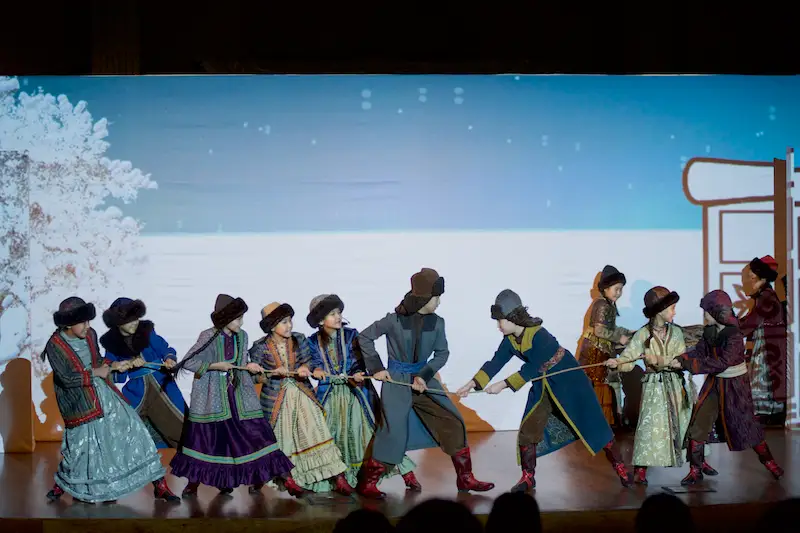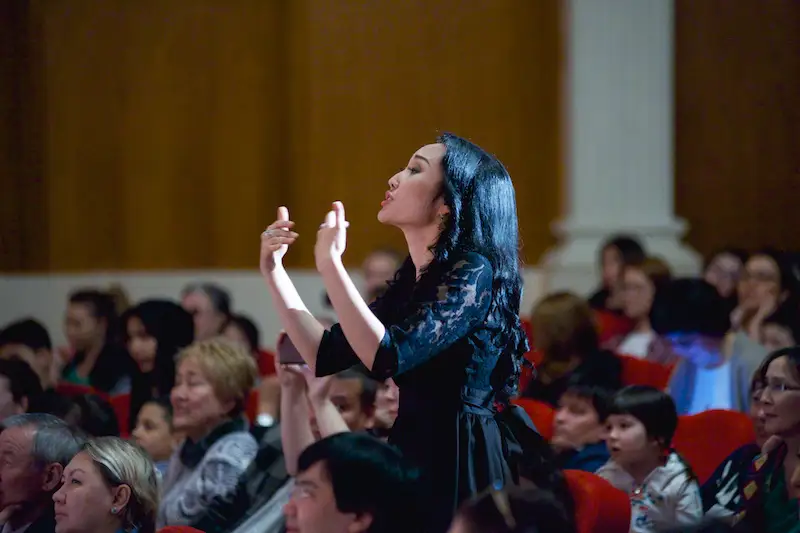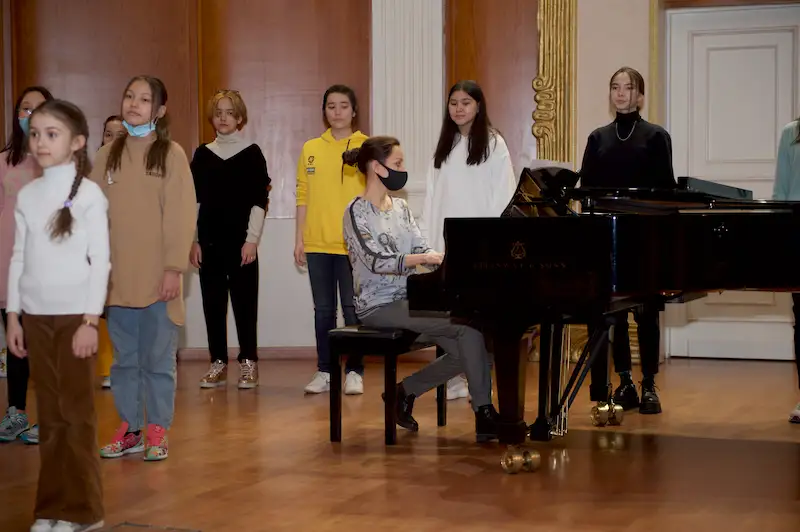Astana Opera offers theatrical lessons and charity projects to children

However, most importantly, the opera house also has a children’s studio. We will tell you in more detail what young artists are taught and what prospects await them in the future.

The children’s studio includes two branches – choir and ballet, where children who have an affinity for music, vocals and ballet are engaged. From its first day of operation, the team of young artists has proven that they are a necessary creative element in the opera house.
Choirmaster Altynganym Akhmetova explains that the children’s studio is a professional team, where children with a certain set of skills study. 90 percent of them study in music schools and know musical notation.

«There is a very rigorous audition process for the studio, because it is impossible to learn opera with a child who does not intonate and has no ear for music. The same applies to ballet. If the applicant has no aptitude, we do not recommend studying classical dance,» Altynganym Akhmetova explained. «The method of working with the choir is the same for both young children and adult artists. The only nuance is that you need to know the specifics of a child’s voice, since it has its own characteristics. It is also necessary to maintain a schedule of work and rest, so that the children maintain proper condition of their voices.»
During the quarantine period, the studio continues its work: the children were divided into groups of up to thirty people, classes are held in the morning and evening.
«We have some children who know the entire repertoire. The kids who started this season are in the process of mastering our performances. We work on acting equally with all of them, studying parts for the children’s choir, honing their skills in groups. At the general rehearsals before the performance and at the performance itself, we unite with the entire cast. Since many children study remotely, rehearsals and participation in operas are a great source of joy for them,» the choirmaster continued.
Over the eight years of the studio’s work, very bright talents have become its pupils. Here children with strongly marked musical abilities studied and performed on the opera house stage. The children who came to the studio in 2013, later, when choosing a profession, linked their lives with creative work in one way or another. The pupils entered the Kazakh National University of Arts, the Kazakh National Academy of Choreography, the Tchaikovsky Music School, as well as universities in Italy, Germany, Austria and Great Britain.
«The repertoire grows every season and there are many tasks for new kids who join our team. Right now children are engaged in 10 performances on the big stage and in a full-fledged children’s production in the Chamber Hall. In addition, our concert repertoire expands every year. Their professional level is also growing, but for me, the indicator of children’s achievements is not their victories in competitions, but their performing skills. When they go onstage and give an excellent performance, when they understand the conductor’s gestures. Or, for example, before the child could not do something, but now he or she can do it,» Altynganym Akhmetova shared.
The closest performance in the opera house’s playbill is Giacomo Puccini’s opera La Boheme, in which 40 children are involved. The special feature of the production is that in the second act the stage rises five metres and the children need to sing from that height. This creates its own difficulties from a technical point of view, but also causes difficulties in the ensemble: the children need to see the conductor and sing together with with the orchestra. In order to get used to the specific ‘high-altitude’ acoustics and perform everything correctly, they rehearse it with them in more detail.

In the eight years of the studio’s existence, its teaching staff, which is based on the opera house team members, has practically not changed. Thus, ballet is taught by experienced dancers performing onstage, in addition, they all have a pedagogical education.

Aigerim Makibayeva has been working in a children’s studio for about three years. Like Altynganym Akhmetova, she is responsible for the sound of the children’s choir.
«We always start the lesson with a vocal warm-up. After that, we learn songs or scenes from operas for the next performances. The duration of the lesson is one and a half to two hours. This is a comfortable time for children. In working with them, I like their simplicity, sincerity most of all. Their positive attitude is very contagious. Sometimes funny things happen to the kids during rehearsals. Work with children is unpredictable. The youngest artists do not always manage to sing and move at the same time. They get confused sometime during the studies, which can look amusing. We can have fun together during the lesson, but we go onstage with full responsibility.»

The opera house’s professional accompanist Irina Kurguzkina provides musical accompaniment during the children’s choir lessons. She says that the importance of her work with children lies in the correct mastering of musical material.
«It does not matter whether it is a concert program or an opera performance, we work out all the same nuances as in working with the soloists. However, with children, explaining new material is more energy-intensive, because everything must be done twice as much and exaggerated, then there will be some percentage of return. In general, you need to repeat many times to a child, diligently convey the details, if he or she obviously did not understand something. Despite the fact that this is a team, the work is still individual. It was a revelation for me that all the kids, without exception, wanted to come back to study in the studio after the lockdown, no one lost interest in art after a long break. They grow up here, become real artists,» Irina said.

The children’s studio also has its own stage director – Nikolai Korshunov, who teaches children acting and stage movement.
«Each child who attends the studio lessons has his or her own individuality, character traits, interests and preferences. I try to bring a charge of energy to the children. I immediately set the tone for the lesson, which helps during rehearsals or when learning mise-en-scènes. That is, I do everything so that the children learn the material. I build a lesson starting from the material I have already given them. I always add something new and if I see that the guys are not coping with the load, we work on some elements again. We draw up a lesson plan, focusing on the composition of the group and the participants’ age. Sometimes the guys suggest something, offer their ideas. I am happy to support them and give children the opportunity to be creative. Whether they become stars or not depends only on their decision. It is very important for me that the kids, coming to the children’s studio, get a good experience that would help them further in life.»
The work of the children’s ballet studio differs from the choral branch. Here, girls and boys are used to working like in a choreographic school. They spend several days a week at the barre, honing every movement. They consider going onstage to be their reward. The first stage experience of the ballet studio students was participating in Minkus’ ballet Don Quixote, which the legendary Milanese Teatro alla Scala presented during its tour on June 30 – July 4, 2014. In October 2014, during the tour of the Mariinsky Theatre, the studio’s pupils took part in the operas Das Rheingold and Die Walküre from Wagner’s epic cycle Der Ring des Nibelungen, conducted by Valery Gergiev.
Amina Aliyeva, a ballet teacher-repetiteur, has tremendous experience in working with children. Many of her students have become famous ballet dancers.
She says that, first of all, the child must understand that without putting all of their energy into classes, there will be no result. In addition, it is important to correctly perceive information in order to then work with your body, without any damage to muscles and ligaments.
«In ballet, a lot depends on the discipline. We require it from children, as well as maintaining a neat appearance. From the first days, the teacher controls the children’s attendance, their punctuality, all of which is required from the child. The turnover of students in the studio is average, but the main cast always remains. Our pupils are involved in performances on the big stage, which brings them great pleasure, and, certainly, in concerts that feature only children’s performances from the opera house’s main repertoire.»

The concertmaster of the ballet studio Elmira Sultangazina has been working with the children’s collective since its inception. The musician notes that the lessons are held three times a week, since the classes do not imply purely academic professional training. However, today many pupils of the studio have been able to enter the Kazakh National Academy of Choreography and continue their studies in more depth.
«The lesson lasts an hour and thirty minutes – a good amount of time for intense physical and mental load for children. Our classes are a practical model of a classic lesson for professional dancers, only of an initial and not such a deep level, of course.»
When it comes to selecting the musical repertoire for the lessons, the accompanist’s task is not only to be able to clearly combine music in the context of the teacher’s choreographic goals, but also to accessibly convey the musical material to students, so that the timing of the pieces they listen to is clear and understandable to everyone in the first year of study. The understanding of the character – major and minor modes (happy – sad), the difference in musical forms, such as mazurka, polonaise, march, the form of cantilena adagio and others, should also be included there. For the ‘little ones’, it is certainly better to use melodically and harmoniously lightened versions of pieces – polkas and scherzos on children’s themes. When working with older children, you can add more complex compositions: rhythmically complicated, harmonically and melodically charged.
It is known that children are the future of our country. The fate of the entire state depends on how we educate the young generation today. Astana Opera, with the support of the Ministry of Culture and Sports of the Republic of Kazakhstan, within the framework of the implementation of the Address of the President of Kazakhstan Kassym-Jomart Tokayev, makes a great contribution to the formation of creative individuals, opens up the wondrous world of high art for them.